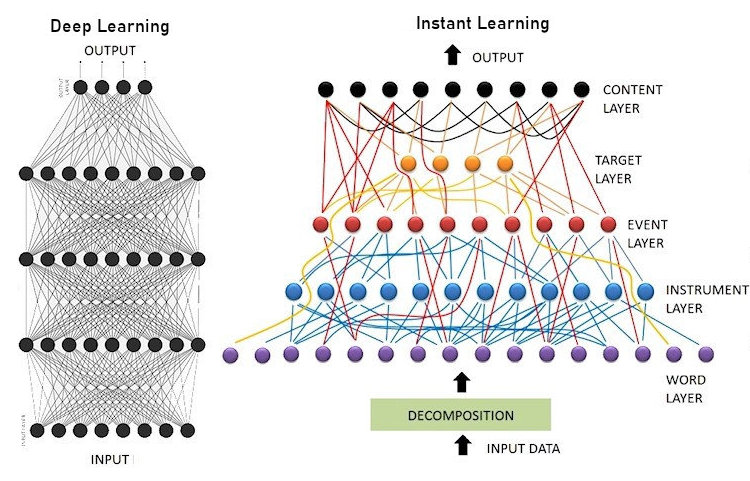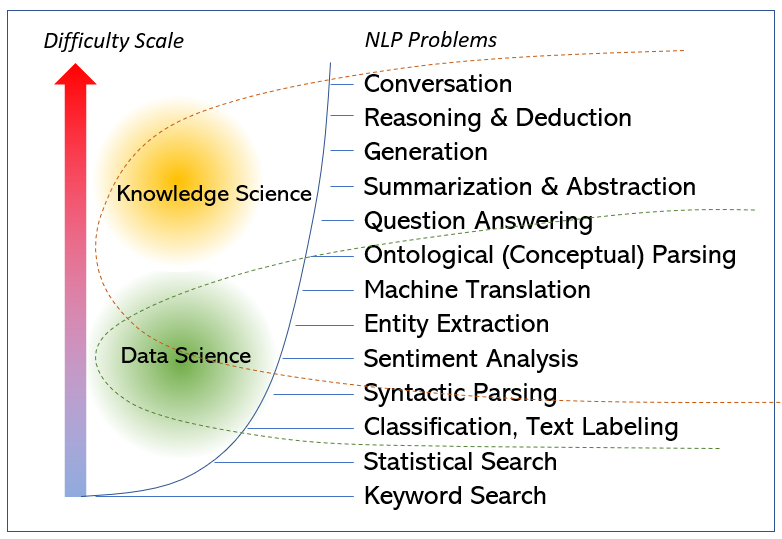In reference to my earlier post about the exClone Case Study reported by Forbes, the future of conversational AI signals a shift from data-driven, expensive, and lengthily methods to knowledge-driven, affordable, and fast methods. In short, it boils down to Deep Learning (DL) versus Instant Learning (or its derivatives).
The two different approaches are summarized in the diagram below.
Practical AI, the right side of the diagram above, uses the existing knowledge on linguistics, ontological semantics, psychology, neuro-sciences, and other cognitive sciences. The resulting hybrid method reduces the load of a machine learning algorithm, turning it into a mere knowledge absorption step from documents (similar to how we read and learn). These documents are about the subject matter of which the conversational system talks about, but nothing more. Simplicity and speed give it the name, instant learning.
Conventional AI, the left side of the diagram, dismisses most (if not all) the existing knowledge, and assumes to solve everything by data crunching. The required data set is assumed to contain examples of all cognitive skills in language processing which is an overly optimistic (if not impossible) expectation.
The Cost Issue
When you have to acquire, validate, and process data, the costs can sky rocket. In my earlier article, the example of Morgan Stanley’s AskResearch system, which is reported to bring answers to somewhat mediocre questions like “What is Morgan Stanley’s standpoint on gold?”, took 1 year to train the system. Obviously, the costs associated with such a process, and data services, would wind up in 7 figures. Not to mention the cost of the required staffing, and the repeating cost cycle in every correction attempt.
In contrast, the practical AI example of exClone’s deployment of Virtual Experts for enterprises can cost 100 or 1000 times less. Because, no data is utilized, no AI staff is required, no coding is necessary, no long training cycles are endured. The only required effort centers around editorial, document management, and curation.
If engineering means finding the most practical and affordable solution, then the sole DL application to NLP may be the worst engineered systems to date!
The Difficulty Scale of NLP
One common problem I see in the DL community is the unawareness of the difficulties of different NLP problems which reminds me of the saying “if the only tool is a hammer…” I made a conceptual scale as shown in the diagram below. Some may argue the ranking of few items. Nevertheless, the exponential nature of the complexity involved in these different problems is indisputable. For example, if your problem at hand is Text Labeling, you are light years away from handling Abstraction. Accordingly, if a DL approach proves successful in the former, it does not mean its readiness in the latter. The differences are huge.
More drastically, data-driven methods have inherent limitations to handle higher level NLP problems no matter the size of the corpus. At the lower end of the scale, most DL applications can be duplicated by statistical linguistics (such as in sentiment analysis) which begs the question “how much better is the conventional AI?”
Conclusion
Data is expensive and risky. Data driven methods make sense to attack problems of high level complexity where (1) the underlying principles are not well known, such is in stock market analysis, or (2) the complexity arises from multi-body nature of the problems, such as in atmospheric modeling or image processing. Applying DL to NLP is treating NLP like atmospheric modeling. More sensible approach is to utilize available knowledge at its maximum, then apply machine learning for the remainder of the problem. This requires innovation of hybrid systems. exClone’s instant learning technology is one good example, however more hybrid solutions are expected to emerge in the near future.
——————————————-
This article is brought to you by exClone, a Virtual Expert & Chatbot technology provider via its proprietary Instant Learning technology.
- Request for a demo at exClone.com
- Join CHATBOTS group in linkedIn.
- You can follow exClone in Facebook, and in LinkedIn.
#AI #ArtificialIntelligence #virtualexperts #chatbots #conversationalAI #ML #DL #deeplearning #Machinelearning #exclone #NLP #humandialoguetheory #instantlearning #virtualreality #VR #StanleyMorgan


